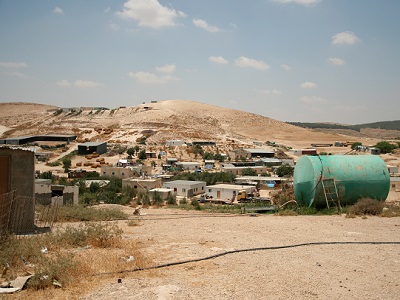
The Bedouin village of Umm el-Hieran in Israel’s southern Negev desert is running out of time and appeals before it will be razed to the ground and an exclusively Jewish town will be built in its place. After a decade of legal battles—a matrix of court cases over lands, houses, and demolition orders—the Bedouins now have one final petition at their disposal, a re-trial. If they lose this hearing their township will be demolished and the saga will end with a modern Jewish bedroom community owned by a private Israeli developer that does not sell homes to Arabs.
“We exhausted the appeals process. What we are trying now is a second hearing/review,” said Khalil Alamour, a lawyer with Adalah the legal group representing Umm el Hieran. “At the same time we are submitting a separate request to ‘freeze’ the demolitions until the hearing.”
In the lead up to the final ruling expected in the next few months the 25 Jewish-Israeli families who want to move into Umm el-Hieran are already living in mobile houses in a nearby nature reserve. They relocated there in 2009. Set behind a barbed-wire fence and a gate, they are ready to motor their caravans downhill to the Bedouin town as soon as the bulldozers remove the last shanty structure. Their hope is to construct 2,500 units serving more than 10,000 Israelis.
Hiran does not have building permits for their trailer park. Yet no demolition orders have ever been issued. Construction inside of nature reserves is strictly forbidden in Israel, Hiran included. Still the community was built openly and with a degree of advertisement by the OR Movement, a private company that seeks to expand Jewish-only communities in sparsely populated regions of Israel. The OR Movement partners with the Israeli government on numerous housing development projects and is the recipient of a handful of state awards for excellence in building new communities.
In 2013 I visited Hiran with colleagues Phil Weiss, Max Blumenthal, Scott Roth and Irene Nasser. We piled into a rental car and roamed the Negev desert until we finally found it tucked deep inside of Yatir forest. The gate opened by remote control and inside we met resident Af-Shalom. After introducing ourselves he told us to wait for a live-in spokesperson, Moshe, who could answer questions. We sat in a courtyard of the trailer park’s synagogue that also hosted a pair of public bathrooms. On an exterior wall a plaque reads, “The landscape development was completed with thanks to the generosity of JNF UK.” Moshe never arrived.
You can read Blumenthal’s storify about our reporting trip here.
From Af Shalom, I learned that most of Hiran’s residents relocated from Susya, a settlement in the south Hebron hills of the West Bank just under a 30-minute drive away. Susya, he told us, is closer to Hiran than Israel’s only major city in the desert, Beersheva and Hiran’s inhabitants keep close ties with the settlement. Weekdays Hiran’s adults travel to Susya to work and the children to school.
– Read more: One last Appeal before a Bedouin Village in the Negev is Demolished and a Jewish Town is Built in Its Place – Mondoweiss





